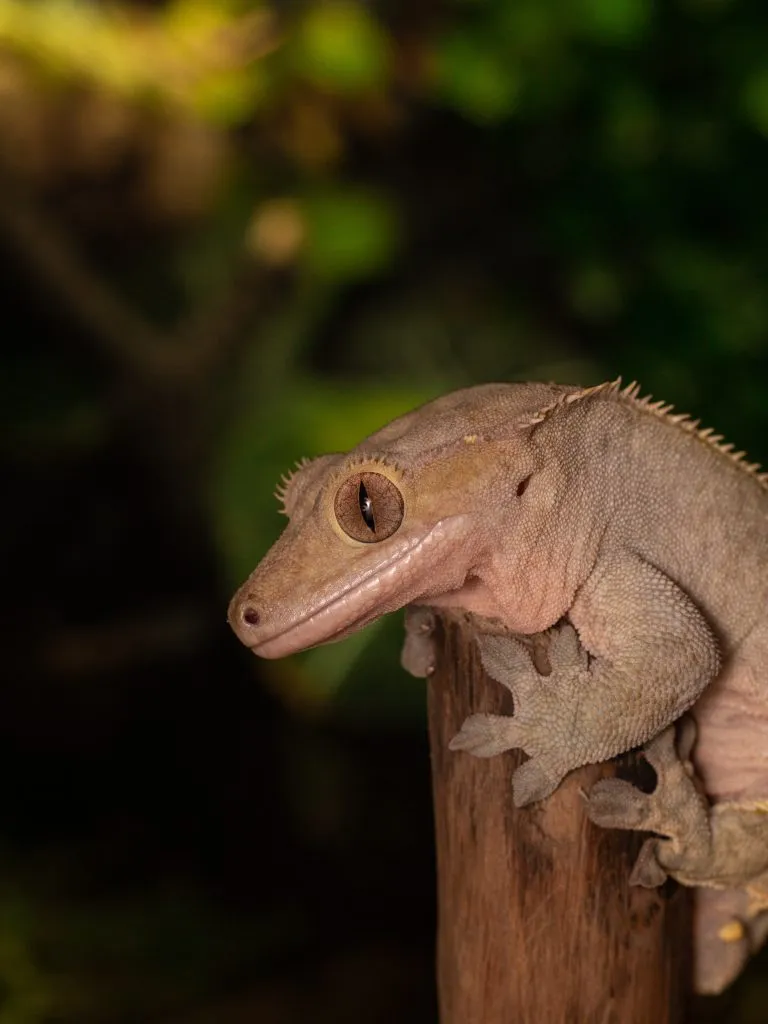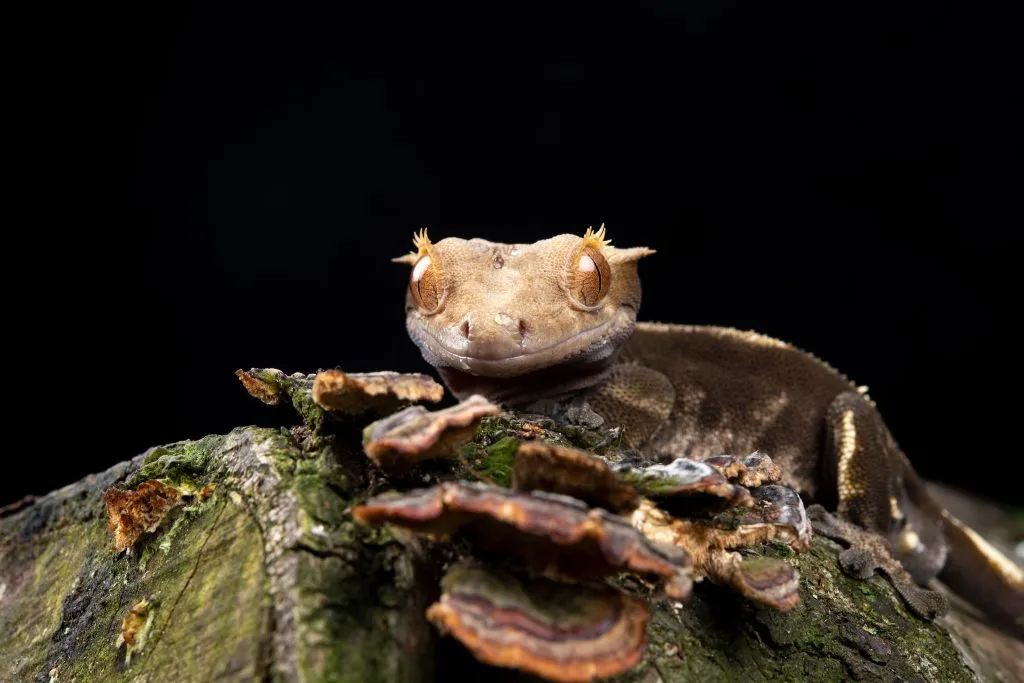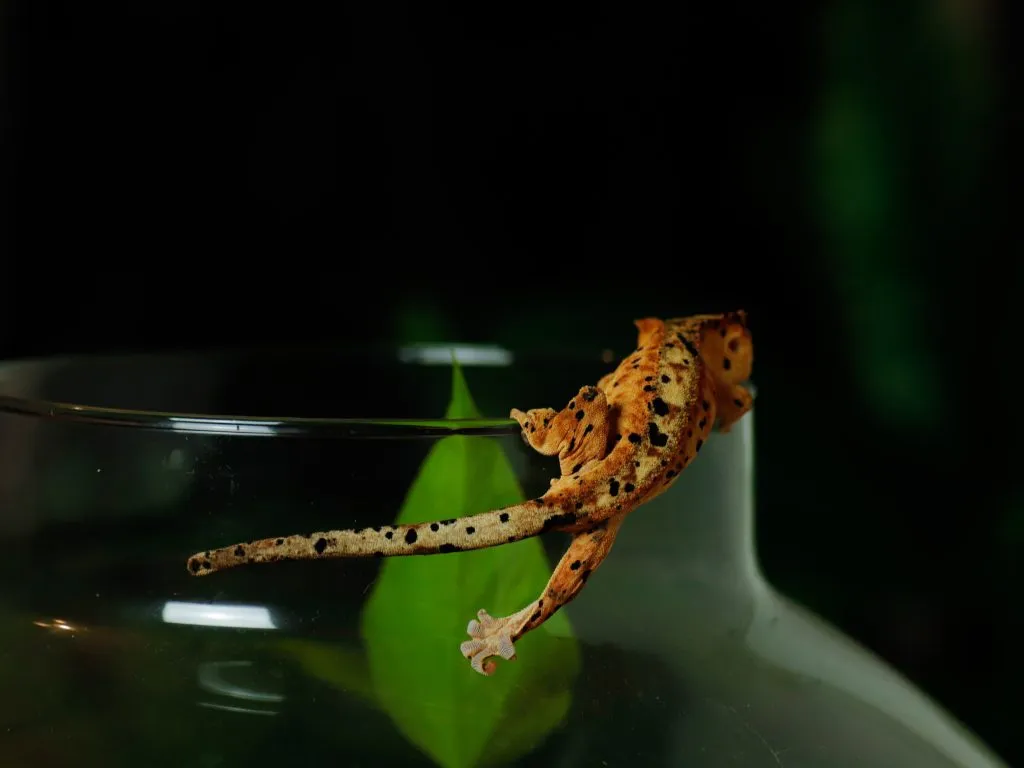
If you keep crested geckos long enough, chances are you are going to encounter a case of tail rot now and then. But what is tail rot and how can you stop it from happening?
Tail rot in crested geckos is a condition where the tail starts to die. It usually starts at the tip of the tail and progresses upward. The tail starts to darken, then dies and shrivels up. Causes of tail rot include injuries, retained shed constricting the tail, and bacterial infection.
Tail rot can be fatal if left untreated. Fortunately, you can take steps to reduce the risks of your crested geckos getting tail rot in the first place. This article will discuss the causes of tail rot as well as treatment and prevention.
Table of Contents
What Does Tail Rot Look Like in Crested Geckos
Tail rot (tail necrosis, or gangrene of the tail) in crested geckos is a condition where part of the tail dies. It is often caused by an infection that occurs when bacteria gain access to the skin of the gecko.
If left untreated, the infection can spread, causing extensive damage to the tail and spreading to other parts of the body.
Typically, this occurs when the crested gecko has a wound or injury which allows these bacteria to infect the skin, but sometimes geckos can develop an infection due to poor diet and improper husbandry.
Tail rot associated with bacterial infection can present as a “wet gangrene”, which makes the area swollen with draining fluid (pus) and a bad smell.
The first signs of tail rot can be very subtle. The affected area may become swollen as infection sets in and inflammation occurs. This stage is usually missed by most crested gecko owners.
As the infection progresses, tissue at the site of infection begins to die. This becomes visible as a discolored or dark area on the tail, usually the tip. At this point, the tissue in the affected area will feel soft and mushy.
As the infection progresses, more and more of the tail becomes involved. The infection starts to have a systemic effect, affecting the crested gecko’s overall health. Lethargy, loss of appetite, and weight loss occur.

When it is time for the gecko to shed its skin, the tail on the skin will not be shed along with the rest of the skin. The skin covering the affected portion of the tail may now be flaky and feel dry to the touch.
As the infection starts to involve more and more of the tail, the tail loses circulation and becomes smaller and thinner.
Tail rot can also be a “dry” infection, or “dry gangrene”, meaning that no pus or drainage is visible. Dry gangrene occurs when initiating cause of tail rot is something other than infection.
An example may be when the blood supply is cut off because of a constricting ring of unshed skin. There may be some initial swelling and then inflammation as the tissue begins to die, but then it starts to darken and shrivel up.
The progression of tail rot is not painless. It affects the crested gecko’s overall health, and it may hide more, bite at its tail, and become grumpy or aggressive in response to the pain and discomfort it is feeling.
In severe cases of tail rot, the affected part of the tail may eventually fall off. A tail that falls off due to tail rot is not the same thing as tail autotomy of geckos, where their tails can detach to get away from predators.
Can Tail Rot Be Fatal For Crested Geckos
If left untreated, tail rot can be fatal for crested geckos. Bacterial infections in the tail rarely remain limited to just the tail.
The bacteria that cause this infection spread into the body. The result can be infections in other parts of the body and damage and damage to vital organs. This can lead to sepsis, a potentially deadly condition.
The gecko can also go into shock from the pain and trauma caused by the tail rot. Shock is a condition where the body’s blood flow is drastically reduced in response to an event such as trauma, which can lead to death.
Tail rot does not have to be fatal though. Early detection and treatment can save your crested gecko’s life. The key is to act quickly and take the appropriate steps to treat tail rot in your crested gecko.
What Are The Causes of Tail Rot in Crested Geckos
We’ve already touched on some of the causes of tail rot in crested geckos. Let’s dig into these a little further.
Bacterial Infection

A common cause of tail rot in crested geckos is a bacterial infection. Bacteria gain access when skin is damaged due to injury or other trauma to the skin.
Injuries can occur if your crested gecko fights with another gecko or if there are sharp or abrasive objects in their
The bacteria that are typically associated with skin and soft tissue infections in reptiles are Aeromonas spp. and Pseudomonas spp., along with a number of other bacteria. These bacteria are often found in the natural environment, on surfaces, and even on other animals.
Even if a bacterial infection is not the main cause of tail rot in your crested gecko, it can quickly become involved and make the condition worse.
Signs of bacterial infection involved in tail rot usually include a draining foul-smelling fluid, or pus. Skin ulcers may also be seen on the affected site.
Also read: Floppy Tail Syndrome in crested geckos – What it is and what to do
Improper Temperature And Humidity
Crested geckos require an environment that has a temperature of 72-78°F during the day, dropping to 69-74°F at night. They also need humidity that is in the range of 60-80%.
Poor housing causes stress in crested geckos, which has negative impacts on their health. Stressed geckos are less able to fight off infection, which can lead to a bacterial infection that then manifests as tail rot.
Inadequate temperature and humidity levels can also cause the skin of your crested gecko to become damaged, allowing bacteria entry points into the body which results in infection.
Improper Shedding
All reptiles regularly shed their skin, including crested geckos. Sometimes, however, the shed skin can become stuck (also known as dysecdysis). This most frequently happens on the appendages – the toes and the tail.
Retained shed on the tail often occurs as a band of tissue that encircles the tail. It looks like an elastic band wrapped around the tail. This restricts blood flow to the tail, and the tail will start to die due to a lack of nourishment.
If bacteria do not become involved, what results is called dry gangrene – the tissues dry up, blacken and shrink. Wet gangrene occurs if it becomes infected with bacteria.
Crested geckos may experience dysecdysis due to a variety of causes, but dehydration, low humidity levels, and malnourishment are the most common culprits.
Malnutrition And Stress

Crested geckos need essential nutrients like calcium, vitamin D3, and vitamins A and C to have strong immune systems. Malnutrition can lead to a weakened immune system, which in turn makes it harder for the gecko to fight off infection.
Malnutrition is usually caused by improper diet. You can learn more about crested gecko dietary requirements in our crested gecko care guide.
Chronic stress also weakens the immune system. Stress can be caused by improper housing conditions, a lack of hiding places, or too much handling (especially during shedding).
Crested geckos with weakened immune systems are more prone to a wide range of ailments including tail rot.
Trauma
Trauma to the tail is another common cause of tail rot in crested geckos. This could be a result of an accident or fight with another gecko, being stuck between
Injuries that may occur as a result of trauma can result in damage to blood vessels which can cut off the blood supply to the tail. This has a similar effect as constriction from retained skin.
Alternatively, the injury can lead to bacterial infection as previously discussed.
It is important to make sure the
How To Treat Tail Rot in Crested Geckos
If you notice that one of your crested geckos has tail rot, the first thing to do is isolate it from the other geckos. This will help prevent the spread to other geckos, if the cause is bacterial, and also makes sure that the affected gecko is not stressed by its companions.
The next step is to have the gecko examined by a veterinarian to see how extensive the damage is, what the underlying cause is, and what the best treatment approach should be.
Surgical Removal
The veterinarian may determine that surgery is needed to remove the affected tissue or part of the tail. This will be done under anesthesia (general or local) so that the gecko does not feel any pain during the procedure.
Your gecko will need post-surgery care and medication. Make sure to follow the veterinarian’s instructions and contact them if you have any concerns about the gecko’s recovery.

Correctly done, surgery can have a result similar to when geckos drop their tails in a flight response. This means they can grow their tailback after the original one is removed, though it won’t grow back exactly like the old one.
If you have caught the problem early enough, though, surgery might not be needed. In that case, the veterinarian will recommend an appropriate treatment to address the underlying cause. This might be removing a retained shed or treating bacterial infection.
Non-surgical Treatment
If your veterinarian has determined that surgery is not required, then they have probably determined that the tail rot is caused by a bacterial infection and is not too extensive. This can be treated with antiseptic cleaning, antibiotics, and supportive care.
With non-surgical treatment, the first thing that needs to be done is to clean the affected area and remove any dead or dying tissue. Your veterinarian will do the initial removal of dead tissue, which is called debriding.
Once the affected area is debrided, it is washed with an antiseptic solution followed by the application of an antibiotic ointment. The ointment will keep the area from drying out and helps to kill bacteria, as well as keep it from drying out.
The antiseptic wash and antibacterial ointment will need to be applied two or three times a day, as per your veterinarian’s instructions.
Supportive care for your gecko will also be needed during treatment, such as keeping it isolated from other geckos so it can recover peacefully and paying close attention to its nutrition.
Can I Just Make My Crested Gecko Drop Its Tail Instead?
Crested geckos, like other geckos, can drop their tail when their life is threatened. This is called tail autotomy. However, the process is not painless. It is not acceptable to do this to your pet under any circumstances.
Furthermore, doing this to your pet gecko can be considered animal cruelty. Many jurisdictions have laws prohibiting animal cruelty, and forcing your gecko to drop its tail may be breaking the law where you live.
The only acceptable way to remove a gecko’s tail is to have it done by a veterinarian. This ensures that the procedure is done properly and without causing any pain or discomfort.
How To Prevent Tail Rot in Crested Geckos
The best medicine is always prevention. Here are some tips to prevent tail rot in crested geckos.
Maintain Correct Tank Conditions
Your crested geckos have no choice but to live in the habitat that you give them, so you must make sure the conditions in the
Make sure that the temperature and humidity levels are at recommended levels for crested geckos. The
It’s also a good idea to separate any aggressive geckos you might have within the
Read our crested gecko care guide for full details on how to create the right
Maintain a Proper Diet

Your gecko’s diet should consist mainly of insects and a small amount of fruits and soft seeds. You have many options when it comes to feeding them live insects, as well as mashed fruit such as pears, mangos, bananas, and strawberries.
The easiest way to make sure your crested gecko’s diet is balanced and complete is to feed it a commercial powdered premix, such as the Repashy Crested Gecko MRP Diet and the Pangea Fruit Mix with Insects.
Make Sure Your Crested Gecko Completes Does Not Have Retained Shed
If you notice that your crested gecko has not fully shed, you will need to help it out. Place it in a small sealed container containing a paper towel soaked with water. This creates an environment with 100% humidity.
Allow the gecko to soak in this high humidity for about 20-30 minutes. Then, once the retained skin is softened, use a moist cloth or cotton swab to gently rub the skin off.
You will also need to correct the underlying condition that might have contributed to the retained shed in the first place, to reduce the chances of it happening again.
Conclusion
Tail rot in crested geckos is a serious condition that can cause permanent damage and even death if left untreated. But with prompt medical attention and proper care, it can be treated successfully.
Remember to take precautions to prevent tail rot by maintaining the correct
- Enchi Ball Python: A Unique and Stunning Morph of Python regius - March 27, 2025
- Emerald Tree Monitor: The Enigmatic Green Guardian of the Rainforest - March 26, 2025
- The Egyptian Cobra (Naja haje): A Fascinating Serpent - March 25, 2025
